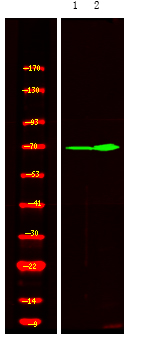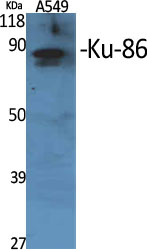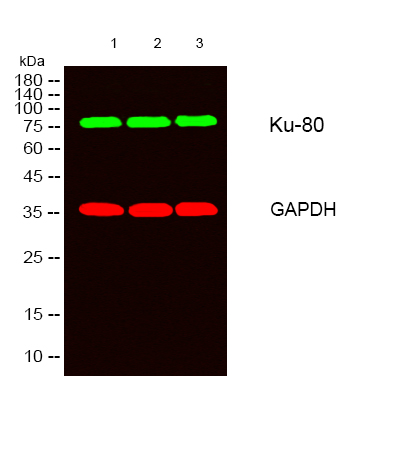XRCC1 (Phospho Thr284) rabbit pAb
- Catalog No.:YP1744
- Applications:WB
- Reactivity:Human;Mouse;Rat
- Target:
- XRCC1
- Fields:
- >>Base excision repair
- Gene Name:
- XRCC1
- Protein Name:
- XRCC1 (Phospho-Thr284)
- Human Gene Id:
- 7515
- Human Swiss Prot No:
- P18887
- Mouse Gene Id:
- 22594
- Mouse Swiss Prot No:
- Q60596
- Rat Gene Id:
- 84495
- Rat Swiss Prot No:
- Q9ESZ0
- Immunogen:
- Synthesized peptide derived from human XRCC1 (Phospho-Thr284)
- Specificity:
- This antibody detects endogenous levels of XRCC1 (Phospho-Thr284) at Human, Mouse,Rat
- Formulation:
- Liquid in PBS containing 50% glycerol, 0.5% BSA and 0.02% sodium azide.
- Source:
- Polyclonal, Rabbit,IgG
- Dilution:
- WB 1:500-2000
- Purification:
- The antibody was affinity-purified from rabbit serum by affinity-chromatography using specific immunogen.
- Concentration:
- 1 mg/ml
- Storage Stability:
- -15°C to -25°C/1 year(Do not lower than -25°C)
- Other Name:
- DNA repair protein XRCC1 (X-ray repair cross-complementing protein 1)
- Molecular Weight(Da):
- 70kD
- Background:
- The protein encoded by this gene is involved in the efficient repair of DNA single-strand breaks formed by exposure to ionizing radiation and alkylating agents. This protein interacts with DNA ligase III, polymerase beta and poly (ADP-ribose) polymerase to participate in the base excision repair pathway. It may play a role in DNA processing during meiogenesis and recombination in germ cells. A rare microsatellite polymorphism in this gene is associated with cancer in patients of varying radiosensitivity. [provided by RefSeq, Jul 2008],
- Function:
- function:Corrects defective DNA strand-break repair and sister chromatid exchange following treatment with ionizing radiation and alkylating agents.,polymorphism:Carriers of the polymorphic Gln-399 allele may be at greater risk for tobacco- and age-related DNA damage.,PTM:Phosphorylation of Ser-371 causes dimer dissociation. Phosphorylation by CK2 promotes interaction with APTX and APLF.,PTM:Sumoylated.,similarity:Contains 2 BRCT domains.,subcellular location:Accumulates at sites of DNA damage.,subunit:Homodimer. Interacts with polynucleotide kinase (PNK), DNA polymerase-beta (POLB) and DNA ligase III (LIG3). Interacts with APTX and APLF.,
- Subcellular Location:
- Nucleus . Moves from the nucleoli to the global nuclear chromatin upon DNA damage. .
- Expression:
- Expressed in fibroblasts, retinal pigmented epithelial cells and lymphoblastoid cells (at protein level).
- June 19-2018
- WESTERN IMMUNOBLOTTING PROTOCOL
- June 19-2018
- IMMUNOHISTOCHEMISTRY-PARAFFIN PROTOCOL
- June 19-2018
- IMMUNOFLUORESCENCE PROTOCOL
- September 08-2020
- FLOW-CYTOMEYRT-PROTOCOL
- May 20-2022
- Cell-Based ELISA│解您多样本WB检测之困扰
- July 13-2018
- CELL-BASED-ELISA-PROTOCOL-FOR-ACETYL-PROTEIN
- July 13-2018
- CELL-BASED-ELISA-PROTOCOL-FOR-PHOSPHO-PROTEIN
- July 13-2018
- Antibody-FAQs
- Products Images

- Western Blot analysis of 1 HeLa cell, 2 LPS 100ng/mL 30min treated ,using primary antibody at 1:1000 dilution. Secondary antibody(catalog#:RS23920) was diluted at 1:10000

